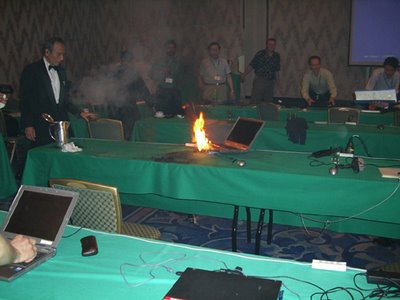The Times views the burning laptop as a parable about Dell customer service, but actually if it's a parable about anything, it's on batteries and our attitudes toward technology. Most of us don't realize just how much energy has been packed into the average mobile device battery. If you release that energy all at once, it can easily cause a nasty fire. A company called Valence, which says it has less dangerous battery technology, distributes fun information on exploding batteries:
Here's a picture of a mobile device battery bursting into flame:

And here's a quote:
"In the last two years alone, the US Product Safety Commission has received approximately 83 reports of incidences of cell phones exploding and/or catching fire injuring consumers due to their batteries. One incident was reported by Curtis Sathre who said 'It was like a bomb going off. His 13-year-old son Michael stood stunned, his ears ringing, hand gushing blood and body covered in black ash. In a split second, fragments from Michael's exploding cell phone had hit him between the eyes and lodged in the ceiling of the family's home in Oceanside, Calif.'"
Four or five years ago, I attended a tech conference called Power. It was a meeting of the leading battery technology companies in high tech. I was there to talk about the future of mobile devices and to tell them what we needed from future batteries. (Our message: more, more, more. Their message: wait for fuel cells. I'm still waiting.)
One of the other speakers was a guy from Dell, and he showed a picture of a laptop that had been destroyed by a battery fire. Cracked screens, blackened plastic, etc. Nasty stuff. He asked, "what if this happens on an airplane?"
(Good question. I hope the answer is that a flight attendant would grab a fire extinguisher and put out the fire, but it would be an unpleasant and dangerous situation, especially since the battery is feeding on its own energy when it burns.)
Anyway, the point being made by the Dell guy was that mobile battery technology needs incredibly stringent quality controls, far beyond typical quality standards. One failure in a million would have laptops and phones melting down every week. The failure rate needs to be more like one in a billion, which is an incredibly difficult task. Meanwhile, we keep on trying to cram as much energy as possible into our mobile devices.
Just one failure in a bad place, the Dell guy said, could hurt the whole industry. Despite a lot of scares since then, the explosive battery story has never really taken off with the general public. People view the incidents as isolated quality control issues, rather than what they really are – symptoms of a technology being pushed to the edge. I don't know if the exploding notebook in Japan will be the crossover event that makes people pay more attention, but it's interesting to see it in the mainstream media. Fortunately, this fire wasn't on a plane.
The lesson in all of this? I think it's given best by one of the photos from the Inquirer website:

Check out the guy in he left foreground. While the Dell burns itself out, he's typing away on his own laptop.
The fact is that we aren't going to give up our mobile devices, so we're all going to live with some risk. But please be careful about buying off-brand lithium ion batteries. You want to get them from a company that's obsessive about quality control.
No comments :
Post a Comment